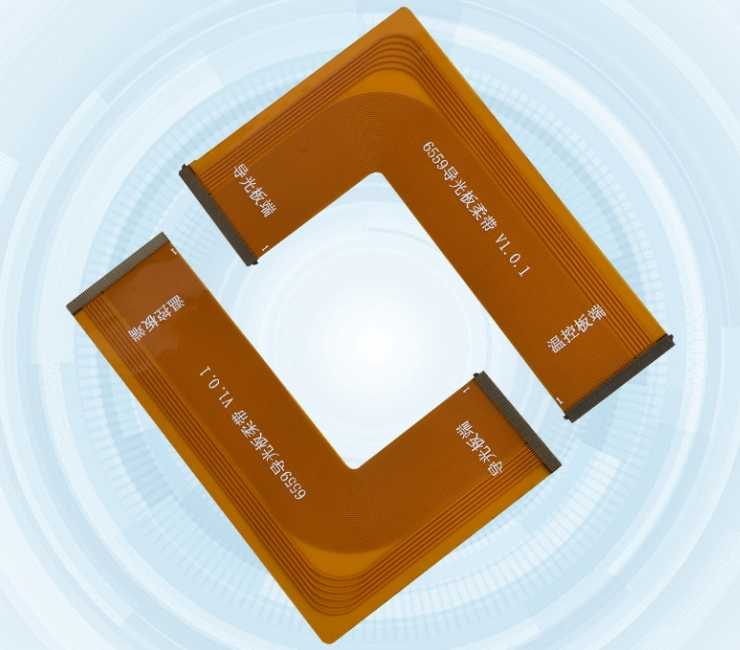FPC (Flexible Printed Circuit) reinforcement materials are used to enhance the mechanical strength and stability of FPC, especially in areas requiring support, such as connectors. Selecting the appropriate reinforcement material is crucial to the performance and reliability of FPC. This typically involves considering the application environment, mechanical strength requirements, and thermal performance. Common reinforcement materials include the following:
1. PI Reinforcement (Polyimide)
- High-Temperature Resistance: PI material has excellent high-temperature resistance, suitable for high-temperature soldering environments.
- Good Flexibility: Compatible with FPC substrates (usually also PI), it can retain a certain degree of flexibility.
- Chemical Resistance: PI is resistant to chemicals and environmental corrosion, making it suitable for harsh conditions.
- Applications: Commonly used in electronics requiring high-temperature soldering or high reliability, such as automotive electronics, aerospace, and industrial control equipment.
2. FR-4 Reinforcement (Fiberglass Epoxy)
- High Mechanical Strength: FR-4 provides excellent mechanical strength and rigidity, offering strong support.
- Strong Rigidity: Compared to flexible materials, FR-4 is relatively hard and suitable for use in areas needing mechanical support.
- High-Temperature Resistance: FR-4 has a certain level of high-temperature resistance, often used in high-temperature soldering.
- Applications: Commonly used in areas needing additional mechanical support, such as FPC connector sections or devices requiring high rigidity.
3. Stainless Steel Reinforcement
- Exceptional Mechanical Strength: Stainless steel offers extremely high mechanical strength, providing excellent support to FPC.
- Heat and Corrosion Resistance: Stainless steel can withstand high temperatures and resist corrosion and oxidation, making it ideal for harsh environments.
- Strong Rigidity: Due to its hardness, stainless steel reinforcement is mainly used in areas requiring very rigid support.
- Applications: Commonly used in heavy-duty equipment and high-wear environments, such as critical parts in industrial or medical equipment.
4. Aluminum Reinforcement
- High Mechanical Strength and Rigidity: Aluminum sheets offer good mechanical support while being lightweight.
- Good Thermal Conductivity: Aluminum has excellent thermal conductivity, aiding in heat dissipation.
- Corrosion Resistance: Aluminum is corrosion-resistant, suitable for devices requiring heat dissipation and corrosion resistance.
- Applications: Commonly used in situations where FPC requires increased rigidity and heat dissipation, such as LED lighting equipment and power electronics modules.
5. PET Reinforcement (Polyethylene Terephthalate)
- Lightweight and Cost-Effective: PET is lightweight and relatively inexpensive, suitable for applications where high strength isn’t necessary but cost-effectiveness is desired.
- Moderate Strength: Compared to PI and FR-4, PET has lower strength and heat resistance, but it’s adequate for some general applications.
- Good Flexibility: PET has good flexibility, suitable for light-load and low-temperature environments.
- Applications: Ideal for low-cost applications with modest requirements, such as simple reinforcement in consumer electronics.
6. Acrylic Reinforcement
- Lightweight and Flexible: Acrylic reinforcement sheets are light and somewhat flexible.
- Low Cost: Suitable for low-cost designs.
- Easy Processing: Acrylic is easy to process and shape, making it suitable for applications requiring high design flexibility.
- Applications: Primarily used in lightweight, low-cost FPC designs, such as some consumer products.
Key Considerations for Selecting Reinforcement Materials:
- Mechanical Strength: Choose FR-4, stainless steel, or aluminum if high mechanical strength or resistance to external forces is needed.
- Thermal Performance: PI or FR-4 is typically preferred for FPC that requires high-temperature soldering or operates in high-temperature environments.
- Flexibility Requirements: If the reinforcement material needs to maintain some flexibility, PI or PET is a better choice, while rigid materials like FR-4 or metal may not be suitable.
- Cost Considerations: For cost-sensitive products, PET or acrylic, which are lower-cost materials, can be selected.
- Environmental Adaptability: For harsh environments, such as those with high temperatures, humidity, or chemical exposure, materials like PI and stainless steel that are heat and corrosion-resistant perform well.
In high-temperature and high-reliability environments, choose PI, FR-4, or stainless steel, which are high-strength, heat-resistant materials.
For flexibility and lightweight requirements, PI or PET flexible materials are preferred.
For high-strength support requirements, FR-4, stainless steel, or aluminum is suitable.
For cost-sensitive consumer products, PET or acrylic economical materials are recommended.
Choosing reinforcement materials requires a comprehensive assessment of the FPC’s application environment, mechanical performance needs, and cost factors to ensure that the FPC’s stability and performance meet design requirements.
Recommended FPC Manufacturer: Gekun
Gekun is a top FPC manufacturer known for high-quality, custom solutions across industries. They offer advanced technology, strict quality control, and cost-effective production. Ideal for reliable, precise FPC needs.
- #FPCManufacturing
- #FlexiblePCBs
- #ReinforcementMaterials
- #Polyimide
- #HighTemperaturePCBs
- #GekunFPC
Gekunflex website: https://gekunflex.com/flat-flexible-printed-circuit-fpc-board/









